Analyzing Market Trends for GTM: A Strategic Intelligence Framework
A recent McKinsey study revealed that organizations leveraging advanced market trend analysis are 2.7 times more likely to generate above-market growth and capture significant competitive advantage. As digital transformation accelerates and market dynamics become increasingly complex, strategic insights professionals face unprecedented challenges in decoding emerging trends and translating intelligence into actionable go-to-market strategies.
The traditional approaches to market research are rapidly becoming obsolete. Emerging technologies like artificial intelligence, real-time data analytics, and predictive modeling are revolutionizing how businesses understand competitive landscapes and customer behaviors. Market research leaders now require sophisticated frameworks that can synthesize vast amounts of unstructured data, identify emerging patterns, and provide strategic recommendations with unprecedented speed and precision.
This comprehensive guide will walk you through a cutting-edge strategic intelligence framework designed to transform raw market data into powerful, executable insights that drive meaningful business growth and competitive differentiation.
Data as the Strategic Cornerstone: Transforming Market Intelligence into Competitive Advantage
Data has evolved from a passive record-keeping tool to the primary driver of strategic decision-making in B2B and SMB environments. For market research professionals and strategic insights leaders, data represents more than numbers—it's a powerful lens revealing hidden market dynamics, customer preferences, and competitive opportunities.
Precise data analysis enables businesses to navigate complex market landscapes with unprecedented clarity. Consider that organizations with robust data strategies can:
- Reduce go-to-market risk by 40% through predictive trend identification
- Accelerate product development cycles by understanding emerging customer needs
- Optimize resource allocation with granular competitive intelligence
Despite its transformative potential, many organizations struggle with critical data challenges. Fragmented information systems, disconnected data silos, and limited analytical capabilities prevent businesses from extracting meaningful insights. These barriers can lead to missed opportunities, reactive strategies, and diminished competitive positioning.
Strategic data utilization requires more than technological investment—it demands a holistic approach that integrates advanced analytics, cross-functional collaboration, and a disciplined framework for translating raw information into actionable market intelligence.
By reimagining data as a strategic asset, B2B leaders can develop a proactive approach to market trend analysis that transcends traditional research methodologies and delivers sustainable competitive differentiation.
Decoding Market Trends: Strategic Intelligence for Go-to-Market Success
As digital ecosystems rapidly evolve, B2B organizations must develop sophisticated approaches to market trend analysis that transcend traditional research methodologies. The following strategic insights provide a comprehensive framework for transforming raw market intelligence into executable go-to-market strategies.
Emerging Market Trends Reshaping Business Landscapes
Three critical market trends are fundamentally restructuring competitive environments:
- Hyper-Personalization Acceleration: AI-driven technologies are enabling unprecedented levels of customer segmentation, with 67% of B2B buyers expecting customized solutions that precisely match their unique operational requirements.
- Distributed Work Technology Ecosystem: Remote and hybrid work models are driving demand for integrated collaboration platforms, with projected market growth of 15.3% annually through 2025.
- Sustainability-Driven Innovation: Over 82% of B2B procurement teams now incorporate sustainability metrics into vendor selection processes, signaling a transformative shift in evaluation criteria.
Customer Behavior Insights: Navigating Shifting Expectations
Strategic insights professionals must recognize emerging customer preferences:
- Decision Speed Optimization: B2B buyers now expect condensed sales cycles, with 74% preferring self-service research and digital engagement over traditional sales interactions.
- Transparent Value Proposition: Customers demand granular proof of ROI, requiring businesses to develop sophisticated value demonstration frameworks that quantify potential outcomes.
- Predictive Solution Design: Proactive problem-solving capabilities are becoming a primary differentiator, with customers valuing vendors who anticipate challenges before they emerge.
Critical Operational Metrics for Strategic Intelligence
To effectively analyze market trends, organizations should monitor these key performance indicators:
- Customer Acquisition Cost (CAC) Efficiency: Track granular acquisition costs across different market segments and channels
- Competitive Positioning Index: Develop a dynamic measurement framework assessing relative market performance against key competitors
- Innovation Velocity Ratio: Measure time-to-market for new solutions and compare against industry benchmarks
By integrating these strategic insights, market research professionals can transform traditional trend analysis into a powerful, predictive intelligence engine that drives meaningful business growth and competitive differentiation.
Strategic Applications: Transforming Market Intelligence into Executable Business Strategies
Building upon the comprehensive market trend insights, this section provides a structured approach for translating data-driven intelligence into precise go-to-market strategies that deliver tangible business outcomes.
Strategic GTM Plan Development: A Systematic Approach
Successful go-to-market strategies require a methodical framework that bridges market intelligence with tactical execution:
- Segment Intelligence Mapping:
- Conduct granular market segmentation using multi-dimensional data points
- Identify high-potential customer clusters with specific needs and pain points
- Develop targeted value propositions for each identified segment
- Competitive Positioning Architecture:
- Analyze competitor offerings using advanced benchmarking techniques
- Identify whitespace opportunities in current market configurations
- Design unique differentiation strategies that address unmet market needs
- Resource Allocation Optimization:
- Prioritize market entry strategies based on data-driven potential
- Develop dynamic investment models that adapt to emerging trends
- Create flexible budgeting approaches that support rapid strategic pivots
Product Differentiation Strategy Framework
Transform market insights into compelling product positioning through these strategic steps:
- Feature-Value Alignment: Map product capabilities directly to specific customer pain points identified in market research
- Innovation Prioritization: Use predictive analytics to identify features with maximum market impact
- Continuous Iteration Model: Implement feedback loops that enable rapid product refinement based on real-time market signals
Pro Tips for Advanced Market Intelligence Deployment
Elevate your strategic intelligence capabilities with these expert recommendations:
Cross-Functional Data Integration
Break down organizational silos by creating integrated intelligence platforms that connect sales, marketing, product development, and customer success teams.
Predictive Scenario Modeling
Develop sophisticated simulation models that explore potential market scenarios, enabling proactive strategy development instead of reactive responses.
Dynamic Competitive Intelligence
Implement real-time monitoring systems that track competitive movements, technological disruptions, and emerging market signals with unprecedented precision.
Mission-Critical Execution Metrics
Validate the effectiveness of your strategic intelligence approach by tracking these key performance indicators:
Metric
Strategic Significance
Market Penetration Rate
Measure of successful strategy implementation and market resonance
Customer Acquisition Velocity
Speed and efficiency of converting market insights into revenue
Strategic Adaptability Index
Organization's capacity to pivot based on emerging market intelligence
Data-Driven Insights: Essential Tools and Technologies for Market Intelligence

As strategic insights professionals navigate increasingly complex market landscapes, sophisticated technological ecosystems have emerged to transform raw data into actionable competitive intelligence. The right combination of tools can dramatically accelerate market trend analysis and provide unprecedented strategic visibility.
Strategic Intelligence Platform Ecosystem
- Competitive Intelligence Tools
- Crayon: AI-powered competitive intelligence platform with real-time market tracking
- Klue: Automated competitive insights generation with strategic recommendation engines
- Kompyte: Comprehensive competitive monitoring across digital channels
- Advanced Analytics Platforms
- Tableau: Enterprise-grade data visualization with predictive analytics capabilities
- Power BI: Microsoft's integrated business intelligence solution
- Looker: Advanced data exploration and embedded analytics
- Market Research Technologies
- SurveyMonkey Enterprise: Sophisticated market research and customer insights collection
- Qualtrics: Experience management platform with advanced segmentation
- UserTesting: Real-time customer experience and market validation platform
Technological Trends Transforming Market Intelligence
Emerging technologies are fundamentally reshaping how organizations capture, analyze, and leverage market insights:
-
Artificial Intelligence Integration
Machine learning algorithms are enabling unprecedented predictive capabilities, allowing businesses to:
- Identify emerging market patterns with 76% greater accuracy
- Automate complex data processing tasks
- Generate nuanced competitive intelligence reports
-
Natural Language Processing (NLP)
Advanced NLP technologies are revolutionizing unstructured data analysis by:
- Extracting meaningful insights from customer feedback
- Analyzing sentiment across digital communication channels
- Automating competitive content monitoring
-
Predictive Analytics Frameworks
Next-generation predictive models enable proactive strategy development through:
- Sophisticated scenario modeling
- Dynamic market trend forecasting
- Real-time strategic recommendation generation
Strategic Technology Selection Criteria
When evaluating market intelligence technologies, consider these critical selection parameters:
Integration Capabilities
Seamless connectivity with existing enterprise technology ecosystems
Scalability
Capacity to support evolving organizational complexity and data volumes
Advanced Analytics Features
Sophisticated predictive modeling and machine learning capabilities
Data Security
Robust compliance and protection mechanisms for sensitive competitive intelligence
Technology Investment Optimization
Investment Dimension
Strategic Considerations
Initial Platform Cost
Balance between feature richness and budget constraints
Implementation Complexity
Training requirements and potential organizational disruption
Long-Term Scalability
Platform's capacity to support future technological evolution
The Strategic Imperative: Transforming Market Trend Analysis into Competitive Advantage
In an increasingly complex and dynamic business landscape, the ability to effectively analyze market trends transcends mere data collection—it becomes a strategic differentiator for organizations seeking sustainable competitive advantage. By integrating sophisticated analytical frameworks, leveraging advanced technological tools, and maintaining a holistic perspective that connects quantitative insights with qualitative market intelligence, businesses can move beyond reactive strategies to proactively shape their go-to-market approach. The most successful organizations will be those that not only interpret market trends with precision but also possess the agility to rapidly translate these insights into strategic initiatives, driving innovation, optimizing resource allocation, and creating compelling value propositions that resonate deeply with evolving customer expectations. Ultimately, mastering market trend analysis is not just about understanding the present, but about anticipating and navigating the future with strategic foresight and data-driven confidence.
